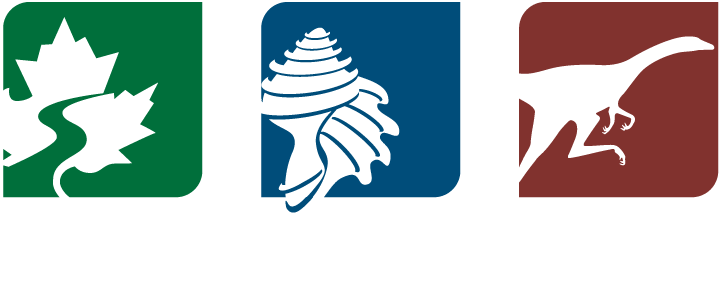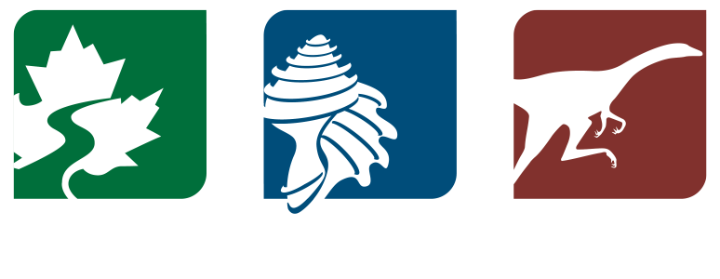Lucy Edwards
Lucy Edwards
Lucy Edwards
Micropaleontologist & Biostratigrapher
Lucy Edwards is a micropaleontologist and biostatigrapher. She uses dinoflagellate cysts (the resting stage for a group of algae) to understand the ages and relationships of rock units, as well as ancient environments.
Lucy graduated from high school in 1969. At that time, the University of Virginia only admitted men, and she did not want to go to a separate women’s college or to the more rural Virginia Tech (Virginia Tech is located in Blacksburg, southwestern Virginia). She moved as far away from home as possible and went to the University of Oregon. By the end of her first year, she knew she wanted to be a micropaleontologist, or a paleontologist that studies tiny fossils that have to be examined using a microscope.
In college, Lucy took years of biology and a year each of chemistry and physics. She also took math and computer science, which in those days meant using punch cards and slide rules. Lucy received her Ph.D. from the University of California at Riverside in 1977. While a Ph.D. student, she spent two summers at Exxon Production Research Company in Houston, Texas. Although there were no female professionals there, Exxon hired women for summer graduate student jobs (they began to hire women professionally soon thereafter).
As Lucy was writing up her dissertation—a typically book-length work describing a Ph.D. research project—she began to apply for jobs. She had always assumed that she would teach at a university, like her parents and grandfather. However, she ended up taking a job as a dinoflagellate biostratigrapher at the United States Geological Survey (USGS). Lucy was at the right place at the right time, and her strength in math and computers was just what the USGS was looking for. Lucy joined the USGS in 1977, working as a Research Geologist until 2018. She is now retired with the title of Scientist Emerita. (“Emerita” or “Emeritus” status denotes someone who is retired, but typically still active in their field.)
Lucy’s research specialties are biostratigraphy, paleoecology, taxonomy (the scientific naming of organisms), and taphonomy (the study of how organisms are preserved in the fossil record). She is especially interested in the stratigraphy—or the age and relationships of rock units—of the Atlantic and Gulf Coastal Plains. Her research uses Mesozoic (252 to 66 million years ago) and Cenozoic (66 million years ago to the present) dinoflagellate cysts. Dinoflagellates are a group of algae, and dinoflagellate cysts are their resting stages. Dinoflagellate cysts have tough outer walls that protect the organism inside, and the walls of these cysts can be preserved in the fossil record.
Daring to Dig Interview
In this video, Lucy discusses her experiences as a student and a Research Geologist at the USGS.
Content note: This video includes a brief discussion of sexual harassment.
Dinoflagellate cysts
The dinoflagellate cysts below come from the late Eocene (38 to 34 million years old) Chesapeake Bay Impact Crater off the coast of eastern Virginia, one of the regions that Lucy has worked on (for more illustrations, see Edwards, 2012). (The images below are in a gallery; click on each to see complete image and caption.)
Selected technical works by Lucy Edwards
Edwards, L.E. 2001. Geology and paleontology of five cores from Screven and Burke counties, eastern Georgia. US Geological Survey Professional Paper 1603. Link
Edwards, L.E. 2012. Dinocyst taphonomy, impact craters, cyst ghosts and the Paleocene-Eocene thermal maximum (PETM). Palynology 36: 80–95. Link
Edwards, L.E., D.S. Powars, G.S. Gohn, and H. Dypvik. 2009. Geologic columns for the ICDP-USGS Eyreville A and B Cores, Chesapeake Bay impact structure: Sediment-clast breccias, 1096 to 444 m depth. Pp. 51–89 in G.S. Gohn, C. Koeberl, K.G. Miller, and W.U. Reimold (eds.) The ICDP-USGS Deep Drilling Project in the Chesapeake Bay impact structure: Results from the Eyreville core holes. Special Paper of the Geological Society of America 458. Link
Edwards, L.E., D.S. Powars, J.W. Horton, Jr., G.S. Gohn, J.M. Self-Trail, and R.J. Litwin. 2010. Inside the crater, outside the crater: Stratigraphic details of the margin of the Chesapeake Bay impact structure, Virginia, USA. Pp. 319–393 in R.L. Gibson and W.U. Reimold (eds.), Large meteorite impacts and planetary evolution IV. Geological Society of America Special Paper 465. Link
Edwards, L.E., R.E. Weems, M.W. Carter, D.B. Spears, and D.S. Powars. 2018. The significance of dinoflagellates in the Miocene Choptank Formation beneath the Midlothian gravels in the southeastern Virginia Piedmont. Stratigraphy 15: 179–195. Link
Weems, R.E., J.M. Self-Trail, and L.E. Edwards. 2019. Cross section of the North Carolina Coastal Plain from Enfield through Cape Hatteras. Open-File Report 2019-1145. Link
Selected USGS outreach publications by Lucy Edwards
Edwards, L.E., and J. Pojeta, Jr. 1993. Fossils, rocks, and time. USGS General Interest Publication. Link
Powars, D.S., L.E. Edwards, G.S. Gohn, and J.W. Horton Jr. 2015. The Chesapeake Bay impact structure. USGS Fact Sheet 2015-3071. Link
Selected commentaries by Lucy Edwards
Edwards, L.E. 2015. What is the Antropocene? Eos, 30 November 2015. Link
Edwards, L.E., D.A.T. Harper, and P.L. Gibbard. 2017. Anthropocene: keep communication clear. Nature 541: 464. Link
Finney, S.C., and L.E. Edwards. 2016. The “Anthropocene” epoch: Scientific decision or political statement? GSA Today 26: 4–10. Link
Further reading
Geiger, B. 2017. Meet our trashy ‘technosphere.’ Science News for Students, 24 January 2017. Link
Madren, C. 2013. Lucy Edwards tells time by microfossils. AAAS Member Spotlight, 30 August 2013. Link




